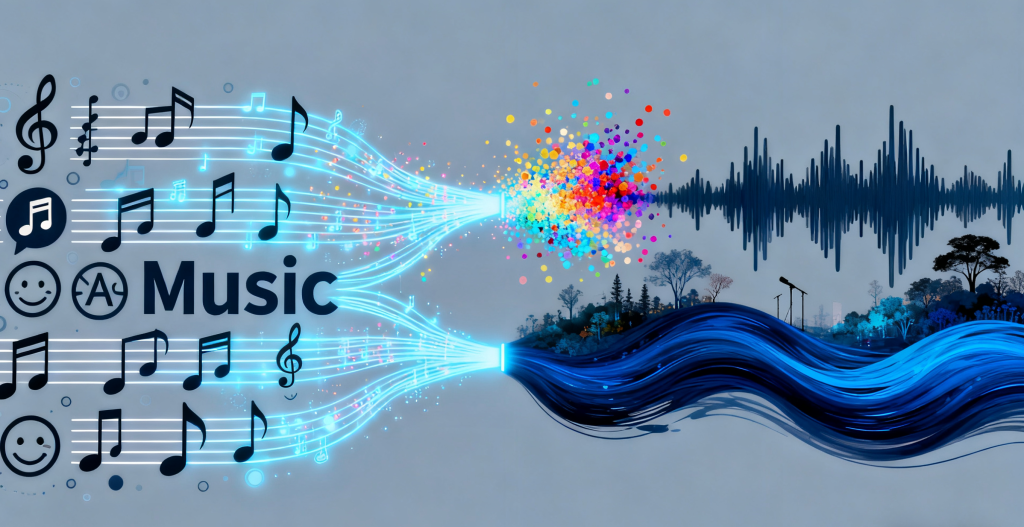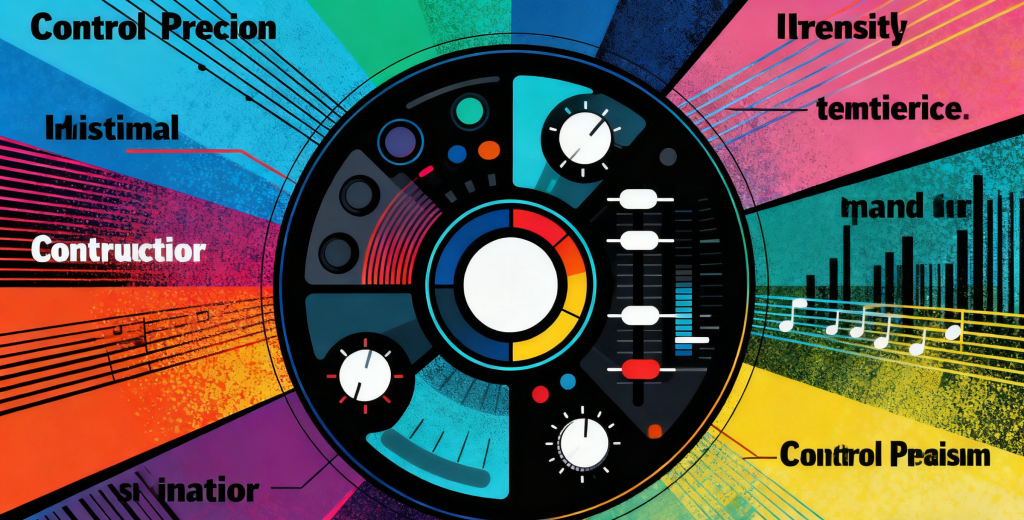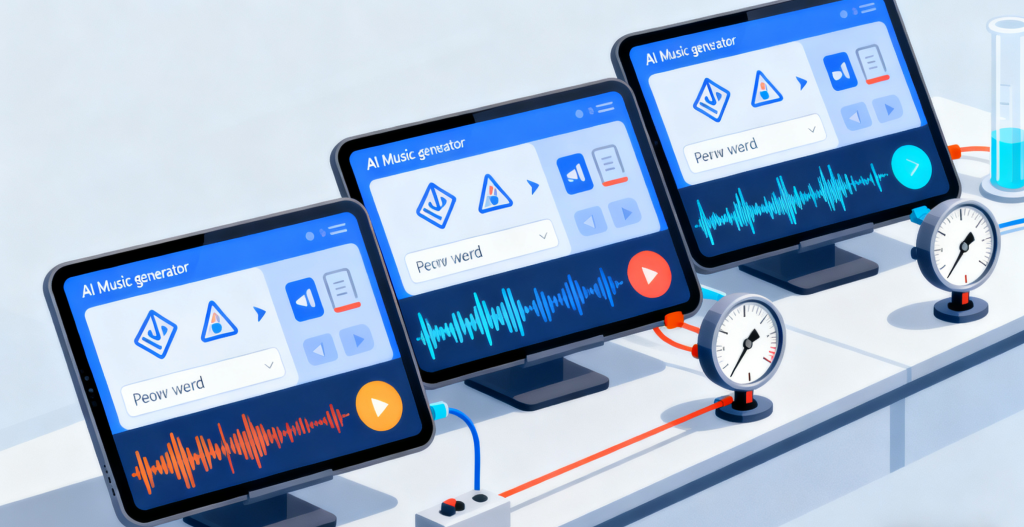Crafting text prompts that yield precise musical results remains a critical challenge for AI music generators. This article explores how prompt fidelity shapes creative control by dissecting key elements of effective instructions, examining how generative models translate concepts into sound, and comparing leading platforms’ prompt accuracy. It tests precision across genre, mood, instrumentation, tempo, and lyrics, then drills into advanced techniques—from iterative refinement to prompt chaining—that empower musicians and content creators. Along the way, readers will discover how Mureka’s AI Music Generator and its built-in editor deliver high-quality, customizable, royalty-free music with unmatched prompt adherence. The following sections cover: foundational prompt elements; AI interpretation mechanisms; Mureka’s unique approach; comparative accuracy analysis; advanced engineering techniques; workflow impacts; emerging trends for 2025 and beyond; and hands-on resources for mastering prompt precision with Mureka’s platform.
What Are the Key Elements of an Effective AI Music Prompt?
An effective AI music prompt defines the creative vision by specifying essential musical attributes that guide generation. Clear instructions on genre, mood, instrumentation, tempo, rhythm, structure, and lyrics ensure the model aligns output with user intent. By articulating these components, prompt writers reduce ambiguity, minimize unintended stylistic shifts, and achieve repeatable results across iterations. Understanding how each element shapes the sonic outcome lays the foundation for precise control and creative consistency.
- Genre & Style: Naming a genre or style category sets harmonic and rhythmic conventions that the model follows.
- Mood & Emotion: Emotional descriptors like “uplifting” or “somber” influence chord progressions and melodic contours.
- Instrumentation: Calling out specific instruments or virtual ensembles directs timbral focus and arrangement.
- Tempo & Rhythm: BPM ranges and rhythmic patterns frame energy levels and rhythmic motifs.
- Lyrics & Vocals: Including lyrics or vocal instructions ensures coherent text-to-voice synthesis.
Elements interlock to form a holistic prompt, and mastering their interplay leads to consistent, high-fidelity AI music output.
How Do Genre and Style Influence AI Music Generation?
Genre triggers pre-learned patterns within the model’s training data, steering chord sequences, beat structures, and production textures. When a prompt requests “electronic dance music,” the system selects synthesizer timbres, four-on-the-floor rhythms, and energetic drops. Jazz prompts invoke extended harmonies, swing grooves, and improvisational textures. Specifying substyles—such as “deep house” versus “trance”—sharpens generative focus and reduces stylistic drift across sections.
Why Are Mood and Emotion Critical in AI Music Prompts?
Mood terms function as affective parameters that bias melodic contour, chord tension, and dynamic shaping. Descriptors like “melancholic piano ballad” or “exuberant orchestral fanfare” guide the model’s expressive range. Emotional context aligns harmonic minor scales, ambient textures, or major key uplift, ensuring the output resonates with intended feelings and narrative arcs.
How Does Instrumentation Affect AI Music Output?
Naming instruments—such as “acoustic guitar,” “string quartet,” or “vinyl-style drum kit”—dictates timbral palette and arrangement density. Instrumentation commands inform layer count, stereo placement, and orchestration complexity. A prompt specifying “solo piano” yields sparse textures, while “big band brass section” produces richer harmonic support and sectional interplay.
What Role Do Tempo and Rhythm Play in Prompt Precision?
Tempo anchors pulse and pace, instructing the model on BPM and rhythmic subdivisions. A “120 BPM upbeat groove” prompt sets mid-tempo danceability, whereas “60 BPM ambient soundscape” invites open, evolving patterns. Rhythm patterns—like “syncopated funk beat” or “straight rock four-on-the-floor”—shape groove authenticity and stylistic consistency.
How Are Lyrics and Vocals Incorporated in AI Music Prompts?

Including lyrics strings within prompts enables text-to-vocals modules to align phonetic content with melodies. Specifying vocal style—“soft jazz crooning” versus “energetic rap flow”—affects prosody, timing, and timbral coloration. Lyrics placement instructions, such as “chorus entry after eight bars,” ensures structural coherence between instrumental and vocal sections.
How Do AI Music Generators Interpret and Execute User Prompts?
AI music generators translate textual instructions into audio via deep learning pipelines that map language embeddings to musical representations. A typical workflow encodes prompt tokens, processes them through transformer-based architectures, and decodes latent features into MIDI or waveform outputs. This mechanism combines pattern recognition from vast musical datasets with generative sampling techniques to realize the user’s vision.
What AI Technologies Enable Prompt Fidelity in Music Generation?
Transformer networks, convolutional sequence models, and variational autoencoders underpin modern music generation. Attention layers link text embeddings to musical tokens, enabling dynamic adjustment of harmony, rhythm, and timbre. Pre-trained large language models extended to audio tasks provide contextual understanding, while diffusion-based decoders refine raw audio waveforms to professional quality.
What Challenges Affect AI Prompt Accuracy and Control?
Ambiguity in natural language, sparse attribute specification, and conflicting descriptors can cause the model to default to generic outputs. Hallucinations—unexpected stylistic artifacts—emerge when the system over-relies on statistical priors without sufficient constraints. Latency in iterative refinement and limited human feedback loops further reduce prompt adherence.
A comprehensive evaluation of AI music generation systems often involves testing their ability to adhere to specific creative instructions.
Evaluating AI Music Generation: Prompt Fidelity and Genre Adherence
The evaluator introduces diverse musical prompts designed to test the system’s ability to generate music that aligns with specific genres, moods, and instrumentation. The evaluation focuses on the system’s adherence to the intended creative direction and its ability to capture genre-specific characteristics, ultimately assessing the prompt fidelity.
Workflow-Based Evaluation of Music Generation Systems, S Dadman, 2025
How Does Mureka’s AI Model Ensure Precise Prompt Following?
Mureka’s AI Music Generator employs a dual-stage decoding process that first constructs a MIDI representation from prompt embeddings, then generates high-fidelity audio with an adaptive synthesis engine. This separation of composition and rendering enhances adherence to specified parameters. Real-time preview and stem export facilitate iterative adjustment, ensuring refined control over genre, mood, instrumentation, tempo, and structure.
How Does Human-AI Collaboration Enhance Music Creation?
Interactive refinement within Mureka’s editor allows creators to tweak arrangement, swap instruments, or adjust dynamics on the fly. Human feedback on initial drafts informs subsequent generations, guiding the AI toward the desired aesthetic. This partnership transforms the generator into a creative co-pilot, combining computational power with artistic intuition.
How Does Mureka Compare to Other Top AI Music Generators in Prompt Accuracy?
Comparative analysis across leading platforms reveals that prompt control varies significantly with underlying architecture and customization interfaces. The following table contrasts prompt fidelity features in Mureka, Suno, Udio, and AIVA.
| Platform | Prompt Parameter Control | Customization Depth | Output Quality | Royalty Terms |
|---|---|---|---|---|
| Mureka | Genre, mood, tempo, instruments, lyrics | Advanced editor with stem exports | Professional-grade audio with low artifacts | Royalty-free for commercial use |
| Suno | Genre, style presets, vocal style | Basic parameter sliders | High fidelity vocals, occasional drift | Royalty-free with attribution |
| Udio | Mood tags, tempo range | Limited instrument choice | Consistent beats, moderate detail | Royalty-free up to specific tiers |
| AIVA | Genre, orchestration focus | Orchestral templates | Rich symphonic textures, less modern styles | Commercial license available |
What Are the Differences in Prompt Control Between Mureka, Suno, Udio, and AIVA?
While some providers offer simple tags or style presets, Mureka exposes detailed attributes—allowing users to pinpoint instrumentation, adjust stem levels, and refine arrangement sections. Other generators typically trade off depth of control for ease of use, resulting in broader generative strokes rather than precise adherence.
How Do These Platforms Perform Across Various Music Genres and Prompt Types?
In electronic, pop, and cinematic genres, Mureka’s dual-stage workflow preserves user guidelines more faithfully than models that generate raw waveforms directly. For orchestral prompts, AIVA excels in textural richness but may lack modern mix clarity. Suno’s latest version produces polished vocals but sometimes omits subtle tempo nuances.
What Are Real-World Examples of Prompt Precision from Mureka and Competitors?

Case studies demonstrate that Mureka can interpret multi-layer prompts—such as “ambient piano with whispered vocals at 70 BPM”—and faithfully render each component. Other tools often flatten such prompts into generic textures or misalign vocal timing. These examples underscore the importance of end-to-end prompt pipelines and editor integration.
How Does Royalty-Free Music and Commercial Use Impact Platform Choice?
Platforms that guarantee royalty-free licensing empower creators to deploy AI-generated tracks without legal encumbrances. Mureka’s policy ensures commercial rights retention, making it a preferred solution for content producers, game designers, and marketers seeking prompt-accurate, rights-clear audio.
What Advanced Techniques Improve AI Music Prompt Precision and Control?
Expert prompt engineering extends beyond initial instructions to iterative strategies that refine and perfect outputs. Techniques such as iterative refinement, negative prompting, and prompt chaining enable creators to address inconsistencies, exclude undesired elements, and build complex compositions step by step.
- Iterative Refinement – Adjusting prompts based on preliminary output insights to hone attributes and reduce artifacts.
- Negative Prompts – Specifying elements to avoid, such as “no drums” or “exclude electronic bass,” to focus the model’s attention.
- Prompt Chaining – Breaking down compositions into sequential prompts, generating intros, verses, and bridges in separate passes.
- Specification Best Practices – Using precise descriptors, value ranges, and structural markers for granular control.
These methods unlock layered creativity by leveraging AI model feedback loops and targeted attribute constraints.
How Can Iterative Refinement Enhance AI Music Outputs?
By reviewing an initial draft and then updating prompt parameters—such as increasing tempo, swapping instruments, or changing mood modifiers—users guide the model toward a final version that aligns with their vision. This feedback loop reduces generative drift and converges on optimal results.
The process of refining AI-generated music often involves a cycle of generation, evaluation, and adjustment.
Prompt Engineering for AI Music: Iterative Refinement Techniques
Its applications span a broad spectrum, from creating art and music to generating text and code. The chapter concludes with insights on iterative refinement, a crucial technique for optimizing the output of generative AI models by progressively adjusting prompts based on previous results.
The Essential Guide to Prompt Engineering
What Are Negative Prompts and How Do They Affect Generation?
Negative prompts work by instructing the model which elements to suppress, effectively pruning unwanted textures or instruments. For example, “no percussion” forces the system to omit drum layers, resulting in ambient or orchestral output without rhythmic artifacts.
How Does Prompt Chaining Enable Complex Music Creation?
Prompt chaining divides composition into stages—such as melody creation, harmonic layering, and arrangement refinement—allowing specialized prompts for each phase. This sequential approach builds structural coherence and supports longer, more intricate pieces.
What Are Best Practices for Crafting Highly Specific AI Music Prompts?
Use concrete adjectives, numerical ranges, and clear structural markers. Include section labels—“intro,” “chorus,” “outro”—and refer to time stamps or bar counts. Combine positive and negative descriptors, and reference known production styles or artist influences for nuanced guidance.
How Does Prompt Precision Impact Creative Workflows and User Experience?
Accurate prompt following accelerates ideation, reduces post-production time, and fosters creative confidence. Musicians and content creators spend less effort correcting misaligned outputs and more time experimenting with new ideas. Precise control also enables consistent brand sounds, tailored theme tracks, and on-demand composition across multiple projects.
What Advantages Do Musicians and Content Creators Gain from Accurate Prompt Following?
Creators benefit from higher productivity, predictable results, and reduced trial-and-error cycles. Prompt fidelity streamlines collaboration, enabling teams to share concise instructions rather than manual edits. Consistent output quality enhances workflow continuity and professional polish.
How Does Mureka Support Customization Through Its AI Music Editor?
Mureka’s editor allows real-time parameter tweaking—changing genre tags, adjusting tempo, swapping instruments, and editing stems. Users can solo or mute tracks, refine dynamics, and export individual stems for external mixing. This granular control translates prompt precision into final production quality.
How Does Prompt Fidelity Influence Unique Soundscapes and Artistic Vision?
When models honor nuanced descriptors—like “haunting cello motif” or “syncopated Latin percussion”—artists unlock distinctive textures that differentiate their work. High fidelity fosters novel soundscapes that reflect personal style rather than template-driven results.
Analyzing the output of various AI music generators reveals significant differences in how closely they adhere to user prompts and the overall user experience.
AI Music Generation: Prompt Closeness and User Fidelity Analysis
Through a comparative analysis, the paper highlights the strengths and weaknesses of various AI music generation models, with a particular focus on the closeness of the produced music to the prompt provided, and the subjective user experience in rating the fidelity, richness, and humanness of the generated music.
Music generation using deep learning and generative AI: a systematic review, R Mitra, 2025
What Are Common Prompting Challenges and How Can Users Troubleshoot Them?
Generic outputs often result from under-specified prompts or conflicting descriptors. Users should increase attribute detail, employ negative prompts to eliminate noise, and test variations on phrasing. Reviewing model limitations and adjusting expectations also guides more productive prompt-engineering sessions.
What Are the Emerging Trends in AI Music Prompt Control and Fidelity for 2025 and Beyond?

AI music generation continues evolving with more powerful models, multimodal inputs, and enhanced authenticity checks. Next-generation architectures—such as diffusion-based audio synthesis and integrated vocal solvers—deliver richer timbres and realistic human voices. Image-to-music and audio-to-audio prompting blur creative boundaries by allowing visual or sample triggers to shape compositions. Concurrently, AI-generated music detection tools ensure provenance and authenticity, addressing ethical and legal considerations as usage scales.
How Are New AI Models Advancing Prompt Accuracy and Vocal Quality?
Recent releases like Suno V5 and AIVA Lyra leverage self-supervised pre-training on massive music datasets, resulting in tighter genre fidelity and more natural vocal inflection. Improved text-audio alignment modules reduce timing drift and lyric mispronunciations.
What Role Does Multimodal Input Play in Future AI Music Generation?
Allowing images, video clips, or existing audio samples as prompt seeds expands creative input channels. Models can translate visual moods or rhythmic motifs from sample loops into coherent compositions, enabling cross-disciplinary workflows.
How Is the Market for AI Music Generators Evolving?
The AI music landscape is maturing with subscription tiers, enterprise solutions, and collaborative platforms. Accessibility increases as integrations appear in DAWs, mobile apps, and web-based services. User demographics broaden as non-musicians adopt generative tools for podcasts, video content, and brand sound design.
What Are the Implications of AI-Generated Music Detection and Authenticity?
Emerging detection algorithms analyze spectral fingerprints and latent embeddings to flag AI-synthesized tracks, promoting transparency and intellectual property integrity. Authenticity frameworks and watermarking protocols will become standard to verify origin and usage rights.
Where Can Users Find Resources to Master AI Music Prompt Engineering with Mureka?
Creators seeking hands-on guidance can explore Mureka’s suite of tutorials, case studies, and community-driven examples. Detailed how-to guides walk users through crafting prompts for specific genres, moods, and structures. Sample repositories showcase successful prompt-to-music workflows, illustrating best practices and creative possibilities.
What Guides and Tutorials Does Mureka Offer for Effective Prompt Crafting?
Step-by-step walkthroughs cover basic prompt construction, advanced attribute tuning, and troubleshooting strategies. Each tutorial pairs written explanations with annotated screenshots of the AI Music Editor interface.
How Can Users Access Case Studies and Prompt Examples?
A curated library highlights real-world success stories from musicians, content creators, and producers. Prompts are shared alongside generated audio snippets (with transcripts) to demonstrate prompt precision in action.
What FAQs Address Common Questions About Mureka’s Prompt Accuracy?
Frequently asked topics include optimal phrasing, resolving output drift, and combining multiple attributes. Answers clarify model behavior and editor capabilities without overwhelming users with technical jargon.
How Can Users Provide Feedback to Improve Mureka’s Prompt Fidelity?
In-platform feedback tools let users rate prompt adherence, report anomalies, and suggest attribute enhancements. Collective insights inform ongoing model fine-tuning and editor feature expansion.
Mureka’s combination of intuitive prompt interfaces, advanced AI architecture, and dedicated learning resources empowers creators to achieve high-precision music generation with minimal friction. By mastering these principles and leveraging Mureka’s specialized tools, musicians and producers can translate ideas into polished tracks that faithfully reflect their vision.



